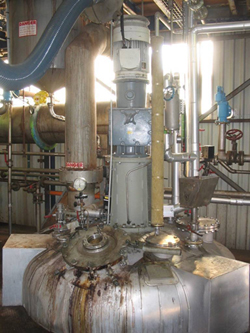Depressurisation model
Depressurisation operations can be realised on various industrial installations: pressure filter, various vessels, centrifuge, etc.
Atmospheric emissions during depressurisation operations are the result of the presence of free solvent vapour in equilibrium with a solvent liquid phase (or residual solvent in cakes for some filtration or centrifuge operations).
In order to apply depressurisation model, following assumptions are made:
- The system pressure is decreased linearly over time,
- Air leakage into the vessel during the operation is negligible,
- The liquid and gas space temperature remains constant during the operation,
- The vapour space of the vessel remains in equilibrium with the volatile liquid contents or residual solvent during the depressurization process.
The following picture represents an underpressure reactor.

Example 1 :
A 1 m3 pressure filter is used to compress a powder containing acetone at 25°C. At the end of the filtration, pressure system is 4 bars. Residual compressed cake as a 0.4 m3 volume.
The system is then depressurised (to discharge of its contents) with a direct atmospheric vent.
Calculated acetone emissions are: 0.717 kg.
Example 2 :
A 6 m3 reactor contains 4 m3 of mixed solvent at 20°C. Weight fractions are: 20% of toluene, 50% of xylene and 30% of MEK.
In order to make a vacuum distillation, pressure is reduced from atmospheric pressure to 150 mbar.
Calculated atmospheric emissions are as follow:
- Toluene : 0.097 kg
- Xylene : 0.066 kg
- MEK : 0.498 kg
- Hatfield, J. A. Improved Algorithm for Estimating Process Emissions from Batch Depressurization, Environmental Progress, Vol. 17 No. 3, pp. 195-198 (Fall 1998).
- EIIP. 2007. Methods for Estimating Air Emissions from Chemical Manufacturing Facilities Chapter 16 in EIIP Volume II.



